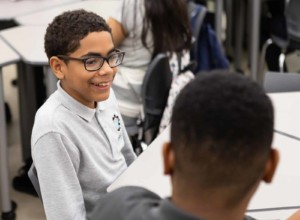Making Good on the Good Schools Promise
Making Good on the Good Schools Promise
Only one thing needs to change in failing high schools—everything.
In the last few days, I have visited four efforts to change everything in urban schools in Los Angeles, Chicago, and New York.
Manuel Arts is a 100 year old high school serving a high need community just west of downtown Los Angeles. MLA Partner Schools recently signed an agreement with LA Unified to exercise management and provide support to the struggling school. MLA earned its stripes with the successful opening of the new West Adams High School—a large neighborhood school that operates six small academies under a unified identity. It’s not like it was easy to open an urban high school, but turning around Manuel is a much heavier lift in part because of the relationships, culture, structure, and curriculum it inherited. The rich array of activities and services on the West Adams campus will soon be extended to Manuel and in a few years results will be better—it will be a pretty good urban school.
Green Dot, a charter management organization, took over Locke High School two years ago after a majority vote of the staff supported the conversion and accepted a new thin contract. The campus still looks like a juvenile detention center but safety, sanity, and education has returned to the campus. Students now feel known, safe, and supported. A beautiful tree rimmed green space (donated by a Hollywood celeb) is the new centerpiece of the campus. Kids are attending at a high rate and more kids are on track to graduate. A handful of small schools are adding a grade per year. In two years, Locke will be a collection of pretty good schools.
VOISE Academy is a new small school located in Austin High School, one of several high schools that Secretary Duncan closed and replaced with new small schools while school CEO in Chicago. Online learning has largely replaced textbooks. Every student has a laptop computer but otherwise the structure and schedule are pretty traditional. The students are typically three years below grade level and often have trouble accessing the curriculum. In a couple years, well prepared students will have access to online Advanced Placement courses, and VOISE will be a pretty good school.
iSchool is a new slightly selective (“only” 65% of kids live in/near poverty) school located in Chelsea high school in Manhattan. Chelsea is a struggling school that will shrink as good new schools replace it. Like VOISE, iSchool blends onsite learning with online learning. The new school is supported by grants and led two talented co-principals and has the attention and support of the NYC Department of Education. If a few years iSchool will be a very good school.
A recent AEI report outlines some important turnaround strategies: new leadership with autonomy, flexibility and the urgency of an all-or-nothing approach. AEI also points out that despite the fact that there are 11,000 schools as needing improvement, there’s almost no capacity in the sector to address the problem—particularly at the high school level.
The list above represents a couple promising strategies to building turnaround capacity:
· Competent school support organizations like MLA Partner Schools in Los Angeles that take a comprehensive approach to meeting the challenge. New York has New Visions for Public Schools. Kansas City has Prep KC Prep. But the list of robust turnaround shops is short.
· GreenDot is one of the few charter networks that has attempted a big school conversion and turnaround.
· Mayoral controlled urban school districts with strong leaders willing to close and replace failing schools with good schools (e.g., VOISE and iSchool). Closing and replacing failing schools is the best alternative we have for getting from really bad to “pretty good” pretty fast.
iSchool will be the best of this bunch because it is small, well supported, well funded, and well staffed. But it’s one schools—we need dozens of iSchool networks serving thousands of urban kids. Charter school networks are most likely to achieve scale with fidelity. And the new stimulus bill will help.
However, all these lessons from school improvement miss a broader point—poverty. Failing schools are always linked to the complex problem of pervasive poverty. Having recently wandered the streets of the Bronx, Brooklyn, Hartford, Newark, west LA, and Chicago, what is most striking is the concentrated poverty. These communities have been underserved for decades with generations trapped in a cycle of unemployment, under-education, and crime. Everyone that could, left. The children left behind often have weak family and community support.
Good schools are a great start to addressing generational poverty—necessary but not sufficient. The wrap around activities and supports of MLA Partner Schools and the community-based organizations (CBO) serving these neighborhoods is an equally important part of the solution. The Recovery Act invests in school improvement as well as community services. It’s a good start. But it really comes down to us, city by city, and the political and personal choices we make. We need to support groups like MLA, Communities in Schools, and local CBOs. We need to support and make the political room to expand effective charter networks and turnaround services. We need to make tough decisions and support courageous leaders. Fulfilling the promise of a good school for every student in America is not a simple equation—but it may be the most important work we do.








0 Comments
Leave a Comment
Your email address will not be published. All fields are required.